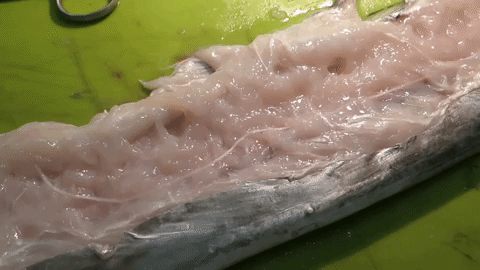Flesh of fish turned liquid by parasite
Filets of mackerel heavily infected by Kudoa thyrsites and soft flesh.
Photo: Arne Levsen / Institute of Marine ResearchPublished: 14.02.2019
“Kudoa are not harmful to humans, or to live fish, for that matter. However, these parasites have the potential to harm the reputation of fish, and hence affect sales”, explains parasitologist Lucilla Giulietti.
The Kudoa thyrsites is a microscopic myxosporean parasite. A tiny spore, the cousin of cnidarians such as jellyfish, corals and sea anemones.
May look fine until you’re about to cook it
The spores penetrate the muscle tissue of the fish in ways yet unknown to science. They lie dormant there until the fish dies. Post-mortem, the Kudoa parasites start producing enzymes that “digest” the fish’s flesh. Within 24–36 hours, it has turned liquid, becoming a slimy fish porridge.
“The difficulty is that the fish looks absolutely fine straight after being caught. It may reach the fish counter and even a customer before the flesh turns liquid”, says Giulietti.
In that case, the customer will get an unappetising surprise.
“In Peru, this may affect around half of all the hake, a common fish. Many people there think that’s just how fish filet looks after a few hours”, she explains.
May affect several tonnes of wild fish
From monitoring Norwegian mackerel catches over the past fifteen years, marine scientists have found Kudoa parasites in up to one percent of fish, or one in every hundred individuals.
“Kudoa are a worldwide group of parasites that are found in many different species of fish. In Norway we have mainly encountered them in pelagic fish, like mackerel. But then again, that’s where we’ve mostly looked”, says Giulietti.
At the request of the fishing industry, the Institute of Marine Research is aboard on several commercial fishing trips a year to search for microbes and parasites in the mackerel catch.

No change in numbers
While other parasites are benefiting from climate change and are multiplying in the warming waters, researchers have fortunately not observed any increase in the number of Kudoa over these past fifteen years. Their presence has remained stable.
“But in 2002 there were big outbreaks of a type of Kudoa in Canadian farmed salmon, causing correspondingly heavy financial losses. The parasite responsible appears to be same species found in Norwegian mackerel. On Iceland, a kind of Kudoa has been found in lumpfish used as cleaner fish in fish farms”, explains Giulietti.
“The Norwegian salmon industry would definitely not want the salmon flesh turning liquid, yet another reason to research this parasite, which we currently know little about.
Porridge is easy to digest?
Italian Lucilla Giulietti has been hired precisely to write a PhD thesis on the biodiversity, infection cycles, life and distribution of Kudoa. Over the coming years she will scour seafloor sediments for microscopic spores, perform genetic analyses and carry out infection experiments on fish. She is starting with a clean slate.
“One of the many questions we have is how Kudoa benefit from turning the flesh of fish into a porridge. Nothing is random in evolution. Mechanisms of this type might be inherited because it helps the parasite spread. In this case, it may make the fish easier to digest for other hosts, if the parasite is transmitted through food, for example”.

